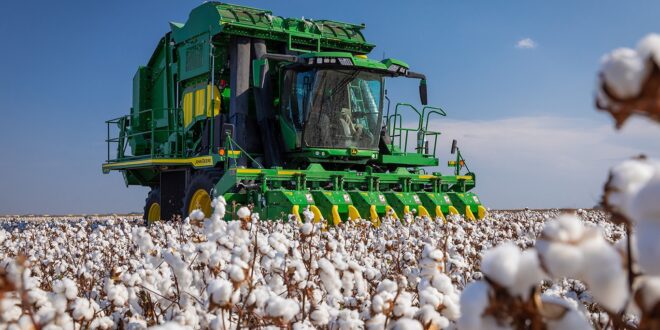The cotton industry has long been a cornerstone of agricultural economies worldwide, providing the raw material for textiles, one of humanity’s most essential commodities. For large-scale cotton farming operations, efficiency is not a luxury—it’s a necessity.
The introduction and widespread adoption of the cotton combine harvester have revolutionized the industry, drastically improving productivity and profitability while reducing the physical and logistical burden of cotton harvesting.
In this blog, we’ll explore the history, functionality, and benefits of the cotton combine harvester and how it continues to shape the future of large-scale cotton operations.
The Evolution of Cotton Harvesting
Before mechanization, cotton harvesting was a labor-intensive process. Workers picked cotton by hand, a slow, grueling method that required large teams of laborers. The invention of the mechanical cotton picker in the early 20th century began to change the landscape of cotton harvesting, but it wasn’t until the development of the cotton combine harvester that the industry saw a dramatic leap in efficiency.
The cotton combine harvester combines multiple functions into one machine, capable of picking, cleaning, and baling cotton in a single pass. This innovation drastically reduces the time, labor, and resources needed to harvest cotton, making it an essential tool for modern agricultural operations.
How the Cotton Combine Harvester Works
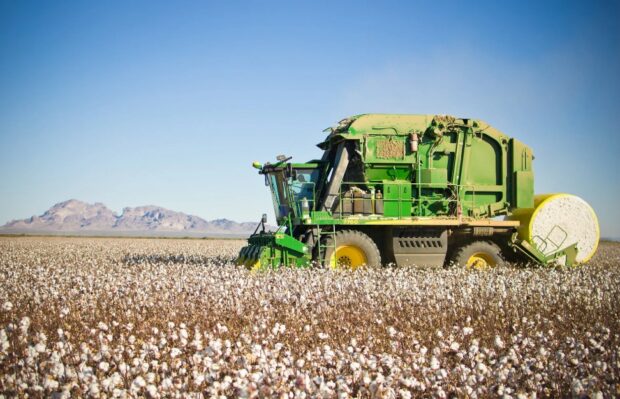
The cotton combine harvester is a complex piece of machinery designed for precision and efficiency. It typically features the following components:
1. Row Units
These units guide the machine along the cotton rows, ensuring accurate picking. The row units use spindles to pluck the cotton from the plants, leaving the rest of the plant intact. This selective harvesting helps maintain the integrity of the cotton fiber and minimizes waste.
2. Airflow System
Once the cotton is picked, it is carried through an airflow system that separates it from debris like leaves and stems. This ensures that the harvested cotton is clean and ready for processing.
3. Baler Mechanism
After cleaning, the cotton is compacted into large, transportable bales. This integrated baling process eliminates the need for additional equipment, saving both time and labor.
4. Advanced GPS and Automation
Modern cotton combine harvesters are equipped with GPS and automation technologies, enabling precision farming. These systems optimize harvesting routes, monitor yield in real time, and reduce fuel consumption, further enhancing operational efficiency.
Key Benefits of Using a Cotton Combine Harvester
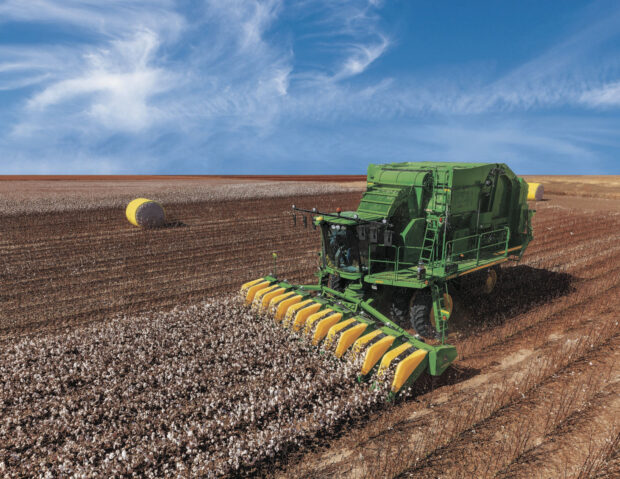
The cotton combine harvester offers several advantages for large-scale operations. Here’s how it boosts efficiency and profitability:
1. Increased Harvesting Speed
One of the cotton combine harvester’s most significant benefits is its ability to harvest vast fields in a fraction of the time it would take with manual labor or less advanced machinery. This speed is particularly critical during peak harvesting seasons when the timing is essential to maximize yield and avoid weather-related crop losses.
2. Reduction in Labor Costs
Labor shortages and rising wages have made manual cotton harvesting increasingly impractical for large-scale operations. By automating the harvesting process, cotton combine harvesters significantly reduce the need for human labor, leading to substantial cost savings.
3. Enhanced Cotton Quality
The precision of the cotton combine harvester ensures that cotton is picked cleanly and efficiently, reducing contamination from dirt and plant matter. Cleaner cotton commands a higher price on the market, directly benefiting farmers’ bottom lines.
4. Optimized Resource Use
Integrated baling and cleaning systems eliminate the need for additional equipment and processes, conserving resources like fuel, time, and maintenance costs. Modern harvesters with GPS and telemetry systems also minimize overlap and waste during harvesting.
5. Environmental Benefits
Efficiency gains translate into fewer passes over the field, reducing soil compaction and fuel consumption. Some models are designed with eco-friendly engines that further minimize emissions.
The Role of Technology in Modern Cotton Combine Harvesters
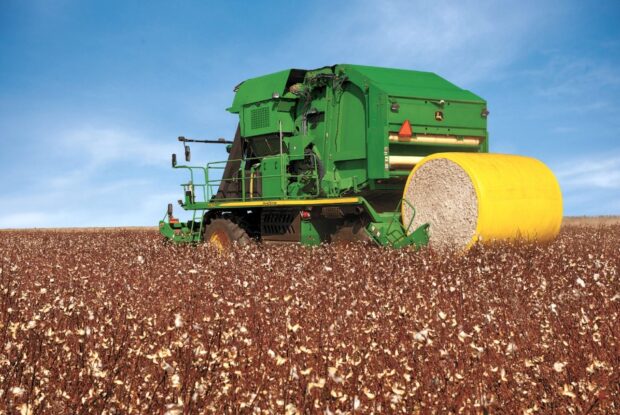
Technological advancements have improved the efficiency of the cotton combine harvester. Features like real-time data analytics, automated guidance systems, and telematics are not just luxuries—they are necessities for staying competitive in today’s market.
1. Real-Time Data Analytics
Modern cotton combine harvesters collect and analyze data during operation, providing insights into yield, moisture content, and field conditions. This data helps farmers make informed decisions about irrigation, fertilization, and crop rotation.
2. Automated Guidance Systems
GPS-guided systems ensure that the harvester follows the most efficient path through the field. This reduces fuel consumption and prevents missed rows or overlaps, saving time and resources.
3. Remote Monitoring and Maintenance
Telematics systems allow operators to monitor the harvester’s performance remotely. Predictive maintenance alerts minimize downtime by identifying potential issues before they become critical.
4. Compatibility with Precision Farming Practices
Cotton combine harvesters are increasingly compatible with precision farming equipment and software, allowing for seamless integration into a larger, data-driven agricultural ecosystem.
The Economic Impact of Cotton Combine Harvesters
The economic advantages of the cotton combine harvester are undeniable for large-scale operations. The initial investment in one can be significant, but the long-term savings in labor, fuel, and equipment more than justify the cost. Additionally, the enhanced cotton quality and faster harvesting times contribute to higher revenues.
Cost Savings Analysis
- Labor ─ Reduces dependency on seasonal workers and mitigates labor shortages.
- Fuel ─ Optimized harvesting routes lower fuel consumption.
- Time ─ Faster harvesting allows farmers to process more acreage in less time.
Revenue Increases
- Cotton quality ─ Cleaner cotton fetches higher market prices.
- Yield preservation ─ Efficient harvesting reduces losses due to weather or delays.
Challenges and Considerations
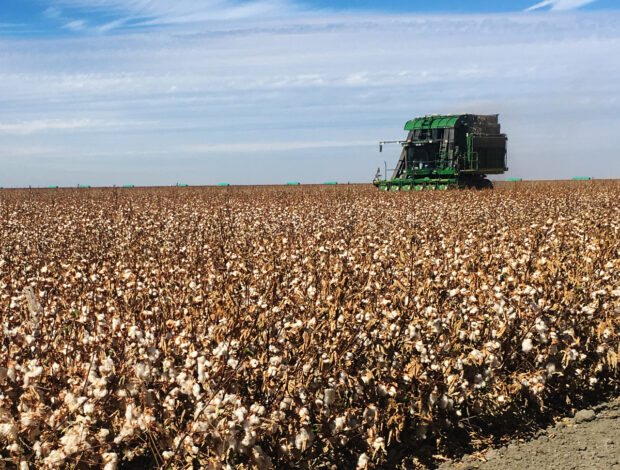
Despite its many advantages, adopting a cotton combine harvester comes with its own set of challenges. Understanding these can help farmers make informed decisions.
1. High Initial Investment
The cost of a cotton combine harvester can be a barrier for small and medium-sized operations. However, financing options and cooperative ownership models can make this technology more accessible.
2. Maintenance Requirements
As with any complex machinery, regular maintenance is essential to ensure optimal performance. Farmers must factor in maintenance costs and potential downtime when planning their operations.
3. Skill Requirements
Operating and maintaining a cotton combine harvester requires specialized knowledge. Proper training for operators and technicians is critical to maximizing the benefits of this technology.
The Future of Cotton Harvesting
As the global demand for cotton continues to rise, the cotton combine harvester will play an increasingly vital role in meeting production needs. Innovations in automation, artificial intelligence, and sustainable farming practices are likely to further enhance the capabilities of these machines.
Upcoming Innovations
- AI-driven decision-making ─ Artificial intelligence could enable harvesters to adapt to varying field conditions in real-time, optimizing performance.
- Sustainable design ─ Future models may include more environmentally friendly features, such as solar-powered components or biodegradable materials.
- Integration with smart farms ─ Cotton combine harvesters will become an integral part of fully automated smart farms, where all equipment communicates seamlessly to maximize efficiency.
Conclusion
The cotton combine harvester is a game-changing innovation that has transformed the way cotton is harvested on large-scale operations. By dramatically increasing efficiency, reducing costs, and improving cotton quality, it has become an indispensable tool for modern agriculture. While challenges like high initial costs and maintenance requirements exist, the long-term benefits far outweigh these hurdles.
For large-scale cotton operations looking to stay competitive in an ever-evolving agricultural landscape, investing in a cotton combine harvester is not just an option—it’s a necessity. As technology continues to advance, these machines will only become more efficient, sustainable, and indispensable.
 Jewel Beat
Jewel Beat
